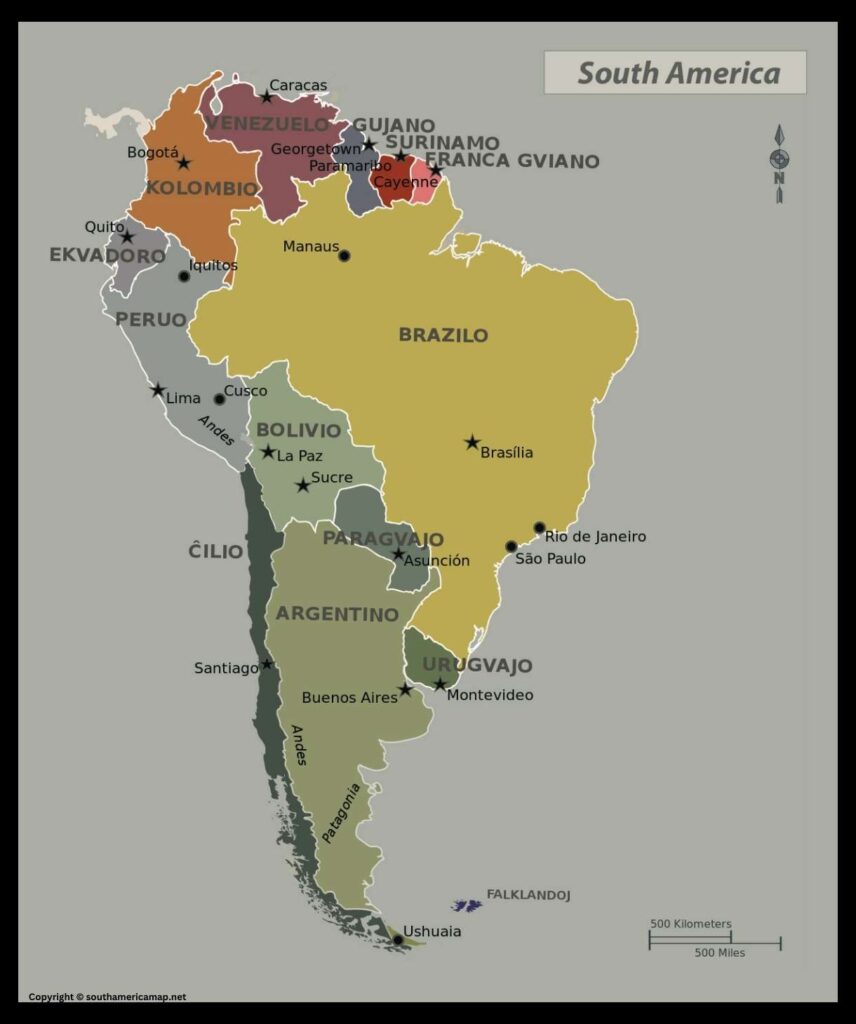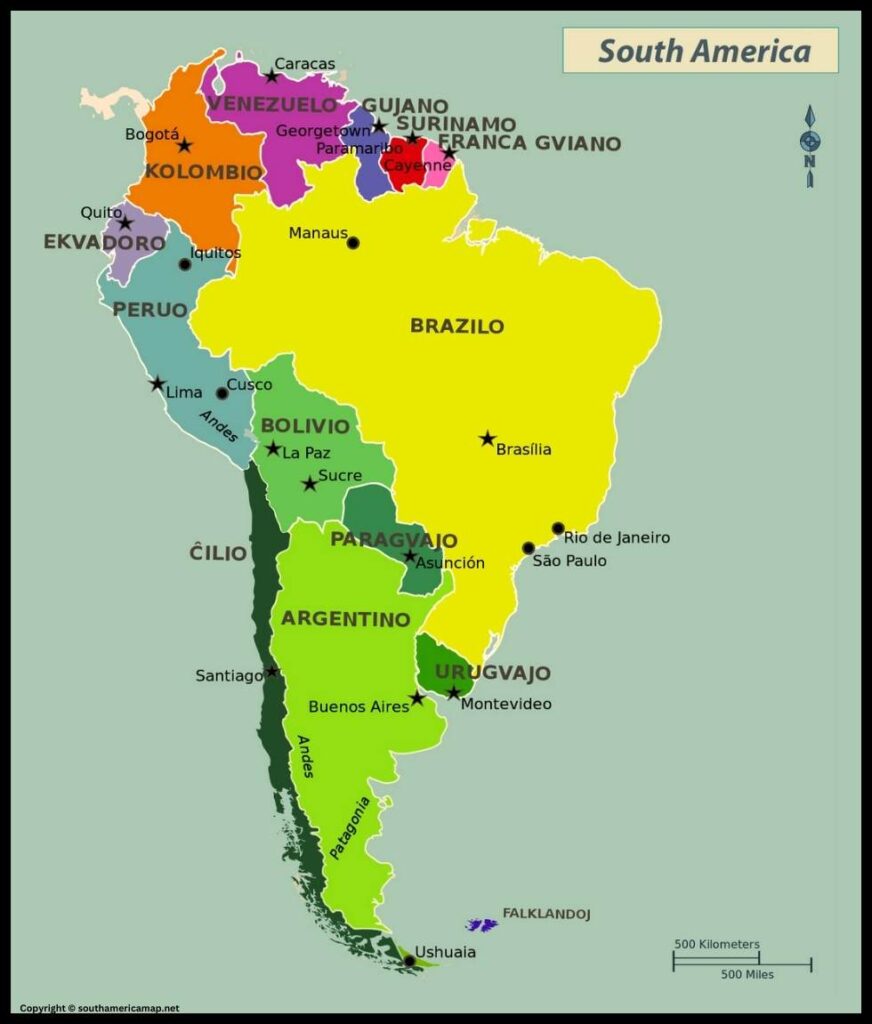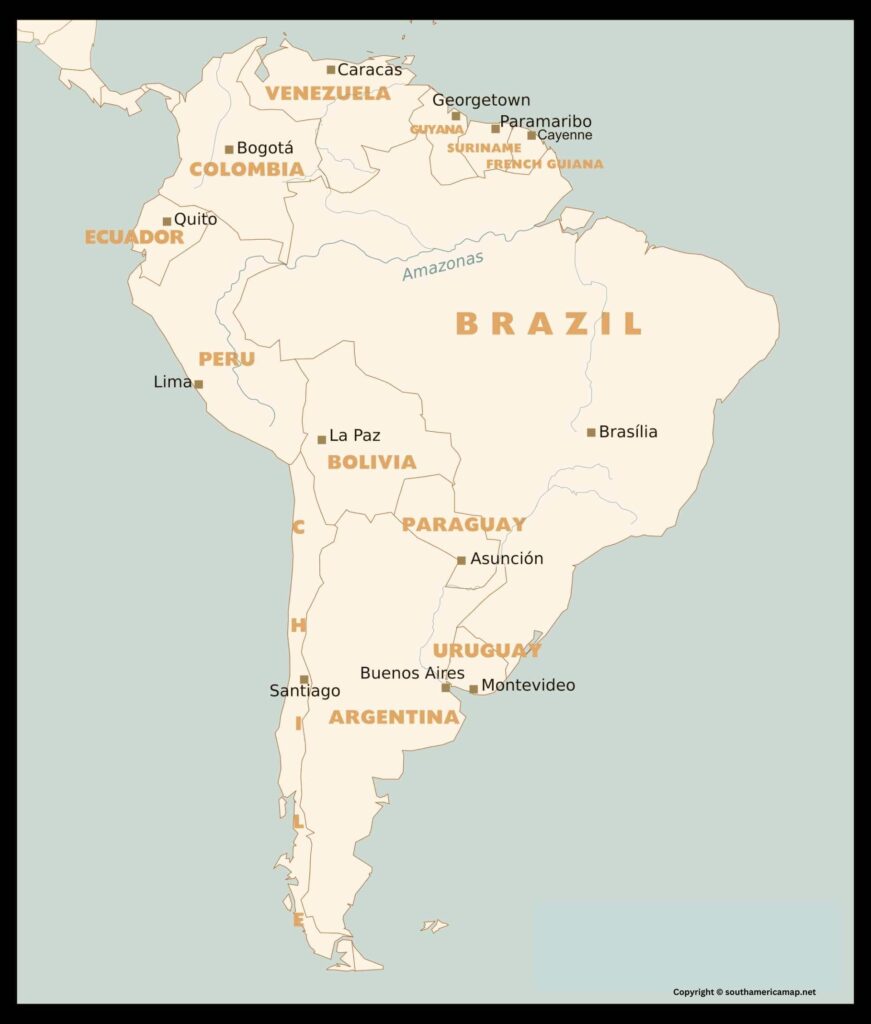The map of South America with capitals is of great importance for a number of reasons, varying from educational and geopolitical to economic and environmental.
Related Post –
South America Map with Capitals
Some of the reasons that make the map of South America with capitals more important are:
- Awareness of Political Factors: Such a map with the capitals can so keenly pinpoint upon the political boundaries of South America. It helps the public understand the layouts of countries and capital cities, promoting geopolitical awareness in the populace.
- Educational Purposes: South American maps help students in geography, history, and social studies concepts. The maps enable learners to identify the countries, capitals, and geographic features.
- Tourism and Awareness: A map with capitals enables those going for tours to international trade fairs so that they can plan their routes, make rough on cities’ distances, and overcome the varying topography of South America.
- Cultural Understanding: Looking at the map, the culture ingrained in knowing the locations of the capitals helps further cultural awareness. Allowing one to enjoy the manifold cultures, language, and historical influences upon the nations of South America.
Map of South America Capitals And Countries
- Economic Planning: Economic planning and analysis of markets using maps with capitals is practiced by business people as well as policy-makers. Recognizing capitals assist in determining economic regional strengths, transport infrastructure, as well as commercial corridors.
- Political Analysis: Analysts dealing in regional politics, global politics, as well as geopolitical current events within South America use maps in identifying regional capitals to identify the locus of power.
- Environmental Conservation: Maps are useful resources to environmentalists and conservationists to safeguard natural resources and biodiversity. Knowledge of the geographical positions of capitals helps in organizing conservation activities and tackling environmental issues.
- Emergency Response: During herbal failures or emergencies, maps with correct capitals are required to coordinate comfort and rescue operations. They help in finding areas which are tormented by the failures, evacuating humans through proper routes, and delivering food to the sufferers.
- Tourism and Hospitality: Maps with capitals are vital for the tourism and hospitality industries. They are used to area tourist sights in journey itineraries and decorate the traveler enjoy.
- International relations: Governments and diplomatic organizations use maps, which depict diplomatic relations, local affiliation and geopolitical members of the family. They provide a reference to understand electricity politics and have an impact on distribution.
The map of South America with Capital is a adaptable useful resource with education, tourism, commerce, environment conservation and use in other fields. It is an important tool for deliberately, cooperation and successful decisions that are in many areas throughout the fields.
Argentina:
- Capital: Buenos Aires
- Geography: Argentina is the world’s eighth-largest nation and features varied landscape, including the Andes mountain range, Pampas grasslands, and the huge Patagonia region. It has an extensive Atlantic coastline.
Bolivia:
- Capital: Sucre (constitutional capital) and La Paz (seat of government)
- Geography: Bolivia is a landlocked nation famous for its high-altitude terrain, which includes the Andes mountain range and the Altiplano plateau. The Amazon Basin reaches into northern Bolivia.
Brazil:
- Capital: Brasília
- Geography: Brazil is the largest nation in South America and encompasses a large and varied geography, including the Amazon Rainforest, the Pantanal wetlands, and long coastlines along the Atlantic Ocean.
Chile:
- Capital: Santiago
- Geography: Chile is a long, thin nation running along the western border of South America. It has the Andes Mountains to the east, a rocky coastline, and varied climates, from the Atacama Desert to the temperate south.
Colombia:
- Capital: Bogotá
- Geography: Colombia is marked by varied topography, such as the Andes, Amazon Rainforest, and Caribbean and Pacific coastlines. It’s the sole South American nation with coastlines on the Atlantic and Pacific Oceans.
Ecuador:
- Capital: Quito
- Geography: Ecuador crosses the equator and is renowned for its varied geography, such as the Galápagos Islands, the Amazon Rainforest, and the Andes Mountains.
Guyana:
- Capital: Georgetown
- Geography: Guyana lies on South America’s north coast and features dense rainforest, savannahs, and the Kaieteur Falls. It is South America’s lone English-speaking nation.
Paraguay:
- Capital: Asunción
- Geography: Paraguay is a landlocked nation and has a large flat area that is bordered by the Paraguay River. The Pantanal, one of South America’s biggest tropical wetlands, is noted for being featured there.
Peru:
- Capital: Lima
- Geography: Peru has varied landscapes, such as the Andes Mountains, the Amazon Rainforest, and a huge coastal desert. It has Machu Picchu, an old Inca city.
Suriname:
- Capital: Paramaribo
- Geography: Suriname lies on the northeastern coast of South America, famous for its dense rainforests, rivers, and varied ethnic composition.
Uruguay:
- Capital: Montevideo
- Geography: Uruguay is a small nation with a highly flat terrain and an Atlantic Ocean coastline. It is famous for its beef production and liberal social policies.
Venezuela:
- Capital: Caracas
- Geography: Venezuela boasts varied landscapes such as the Andes Mountains, the Amazon Rainforest, and long coastlines. It contains Angel Falls, the highest uninterrupted waterfall in the world.
Map of South America with the Capitals
| Country | Capital |
| Argentina | Buenos Aires |
| Bolivia |
Sucre (official) and La Paz (administrative)
|
| Brazil | Brasília |
| Chile | Santiago |
| Colombia | Bogotá |
| Ecuador | Quito |
| Guyana | Georgetown |
| Paraguay | Asunción |
| Peru | Lima |
| Suriname | Paramaribo |
| Uruguay | Montevideo |
| Venezuela | Caracas |
These South American nations together make contributions to the continent’s wealthy cultural tapestry, biodiversity, and geopolitical dynamics. Each state has its specific records, cultural historical past, and herbal wonders.


